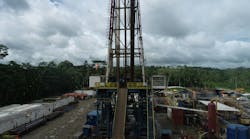It may not have had the snap and sizzle of a study the National Academy of Sciences released the same day, but a report the US Department of Energy unveiled on Sept. 15 also put to rest concerns about natural gas from deep hydraulically fractured wells migrating upward into drinking water supplies.
The study DOE's National Energy Technology Laboratory conducted was limited in scope. It involved only 6 horizontally drilled, fraced Marcellus shale wells in Greene County, Pa., and does not speak to all fracing cases, emphasized Paula Gant, DOE's deputy assistant secretary for oil and gas.
But an interim analysis after 5 months produced preliminary findings of no fluid or gas migration from the wells to a producing gas field 3,800 ft above the fraced formation, but still almost 4,000 ft below drinking water sources, she said.
"The conclusions indicate that impacts from hydraulic fracturing did not extend to the producing gas field well above the stimulated area, and there has been no detectable migration of gas and fluids during the monitored period after fracturing activities took place," Gant said.
During fracing at the Greene County site, researchers detected microseismic signals using downhole geophones, according to NETL's research and development office. All signals recorded were at least 2,000 ft beneath the Upper Devonian/Lower Mississippian gas field, and more than 5,000 ft below drinking water aquifers, it said.
Gas samples from the Upper Devonian/Lower Mississippian gas field were collected 2 months prior to fracing, and up to 8 months after, and no evidence of gas migration was detected, NETL said. Monitoring of the Upper Devonian gas field up to 5 months following fracing produced no evidence of fluid migration, it added.
'Not the final word'
"It's important to recognize that the results of the study are not the final word on surface impacts from hydraulic fracturing operations," said Gant. "But the findings are consistent with prior observations that fracing operations related to Marcellus development at these depths (8,200 ft) can be expected to remain thousands of feet below groundwater sources.
NETL's study was funded from federal oil and gas royalties directed to DOE under provisions of the 2005 Energy Policy Act's Complementary Program. The work was conducted in a collaboration involving government, industry, and academia to provide an unbiased, science-based source of information that might help guide future decisions about shale gas development, NETL said.
"It's another piece to the puzzle of making sure that shale production can help fulfil the great promise of unconventional resources in US energy and economic security, while addressing concerns about the potential health, safety, and environmental impacts," Gant said.

